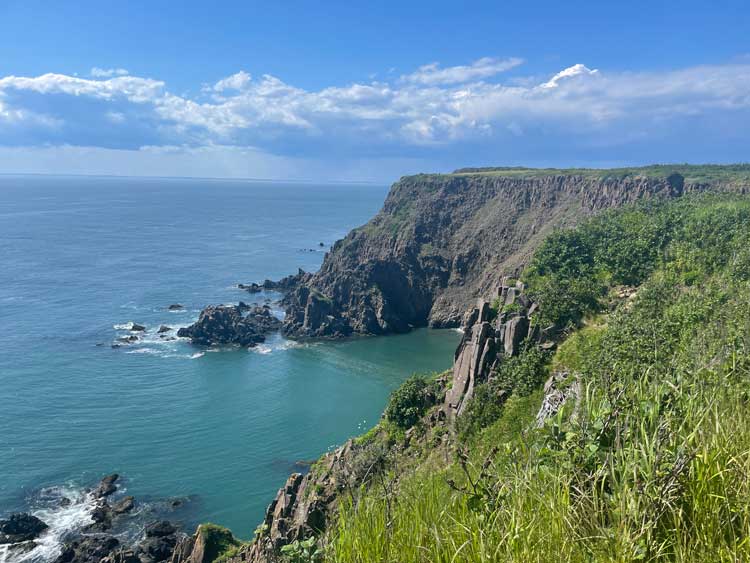
Before I visited New Brunswick, I didn’t know much about the largest Maritime province in Canada. I knew it was somewhere over there in eastern Canada, not too far from Maine, somewhere near the sea. But I couldn’t picture it on a map.
Turns out, New Brunswick has an enviable location nestled against the Atlantic, with the dramatic Bay of Fundy to the southeast and the Gulf of Saint Lawrence to the northeast.
It neighbors Quebec to the north and Nova Scotia to the east. And at times, depending on where you are, you can see the tips of Maine in the distance.
Residents of New Brunswick

With a population of 800,000 in a province with 28,143 square miles, there is plenty of room to roam. The province is 85 percent forested and is known for its untouched wilderness.
I fell in love with the rugged, dramatic coastline that follows 3,400 miles of the coast. There are many inland waterways, and New Brunswick is a popular draw for fishing, hunting and many other outdoor adventure activities.
Most residents of New Brunswick spend their lives near or on the water. Some 60 percent of New Brunswick’s population lives within 30 miles of the coast.
“We believe in the positive impacts being around water has on a person mentally and physically,” one local told me. “We say that blue is the new green.”
New Brunswick Tours & Excursions
New Brunswick Fun Facts

Here are a few other things I learned during my trip to New Brunswick. I can guarantee you, though, it won’t be the last.
- New Brunswick is the only officially bilingual province in Canada with English and French spoken here. Moncton, New Brunswick’s biggest city, was Canada’s first officially bilingual city. During my time there, I listened as many locals switched between the two languages as easy as breathing.
- Acadian culture is an important part of New Brunswick. Acadians are descendants of French settlers who arrived in the area in the 17th and 18th centuries. This is why French and English are both spoken in New Brunswick.
- Acadians share the same roots as the Cajun people of Louisiana
- New Brunswick has the warmest saltwater beaches in Canada. In fact, the province has the warmest saltwater beaches north of the Carolinas.
- The Bay of Fundy is a feeding ground for 12 species of whales, including the endangered North Atlantic Right Whale.

- The Bay of Fundy has the highest tides in the world. The sea level can rise to 56 feet between high and low tide.
- More than 160 billion tons of water rush into the Bay of Fundy with each tide change and there are two tide changes each day. The amount of water that comes into the bay for one tide change is enough to fill the Grand Canyon twice.
- The Marine Biodiversity of the Bay of Fundy is comparable to that of the Amazon rainforest.
- The Bay of Fundy and the Gulf of Mexico are the two fastest warming bodies of water due to climate change.

- St. Martins, a quaint and pretty little fishing village on the Bay of Fundy, is the only place in the world where you can take a photo that includes two covered bridges and a lighthouse. This village also has two UNESCO designations – the UNESCO Fundy Biosphere Reserve and the UNESCO Stonehammer Global Geopark.
- The Bay of Fundy’s mudflats is home to microscopic mud shrimp. These mudflats are a virtual buffet for 95 percent of the world’s semipalmated sandpipers as they migrate from the Arctic to South America for the winter.
- New Brunswick has some of the last pure coastal wilderness on the eastern seaboard of North America.

- New Brunswick has a blend of climates typical of a coastal area and of an inland province. January is generally the coldest month in New Brunswick and July is the warmest. The influx of moist Atlantic air produces mild spells in the winter and some periods of cool weather in the summer.
- Summer days are usually warm and comfortable. Along the Bay of Fundy coast, the average daytime highs run between 68° and 72° F in the summer. The temperature rises are you move inland.
- In the fall and spring, the days are cooler but dry and pleasant. It’s a lovely time to visit.
Learn more about New Brunswick at tourismnewbrunswick.ca
Inspire your next adventure with our articles below:
Want to discover more hidden gems and helpful travel tips? Join our free newsletter for the latest travel secrets and travel articles.
We are reader-supported and may earn a commission on purchases made through links in this article.

